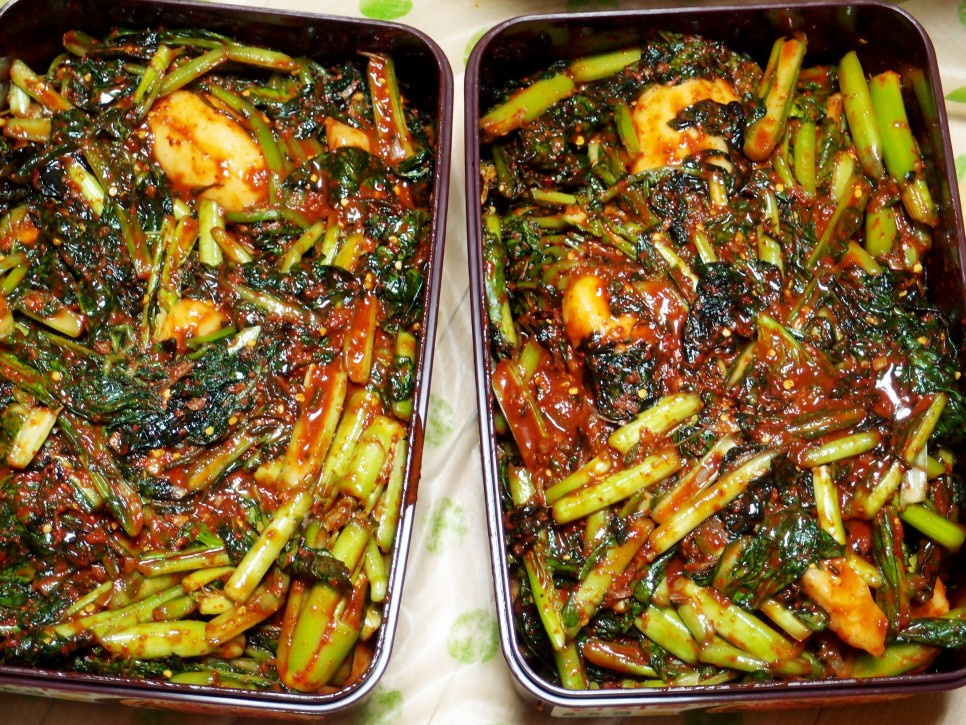Spicy and Refreshing Chogak Kimchi (Radish Greens Kimchi) – Jeolla-do Style
#JeollaStyleKimchiPaste #HowToMakeKimchiPaste #HowToMakeChogakKimchi #CoolKimchiPasteWithToss, Fresh Shrimp, and Dried Anchovies

This post shares a detailed recipe for making delicious Chogak Kimchi, using a special Jeolla-do style kimchi paste that offers a deep and refreshing flavor. The recipe yields enough kimchi paste for approximately 3 heads of napa cabbage, 2 heads of baby napa cabbage, 4kg of brined young radish, plus filling for radish and other ingredients like mustard greens and green onions. We’ll guide you step-by-step, starting with preparing the glutinous rice paste, then making the kimchi paste, and finally trimming and brining the vegetables. While it may seem straightforward, making kimchi is a labor of love, and can feel lonely when done alone. However, with this recipe, you can confidently create delicious Chogak Kimchi.
Jeolla-do Style Kimchi Paste Ingredients- 400g fresh anchovies (ground)
- 1kg fresh shrimp (small size, ground)
- 200g sea tangle (toss) (thawed and lightly blanched, then chopped)
- 8 cups chili powder (gochugaru)
- 3 cups natural seasoning anchovy-broth
- 1 cup minced garlic
- 1 tbsp minced ginger
- 4 tbsp chopped green onions
- 1/2 cup dried chili seeds (from dried peppers)
- 1/2 cup plum extract (maesil-cheong)
- 3 cups anchovy sauce (fish sauce)
- 5 tbsp salted shrimp (finely minced)
- 1.5 cups glutinous rice paste (cooked and cooled)
Chogak Kimchi Ingredients- 4kg brined young radish (washed thoroughly, taste for saltiness)
- 1/5 bunch of Dolsan mustard greens (washed and chopped)
- 4 ladles of prepared kimchi paste (or to taste)
- 4kg brined young radish (washed thoroughly, taste for saltiness)
- 1/5 bunch of Dolsan mustard greens (washed and chopped)
- 4 ladles of prepared kimchi paste (or to taste)
Cooking Instructions
Step 1
Sea tangle (toss) is a unique ingredient that adds a distinct flavor to Jeolla-do style kimchi. Thaw the frozen sea tangle, briefly blanch it in boiling water, and then chop it into bite-sized pieces.

Step 2
Grind the fresh anchovies into a fine paste using a blender or mortar. Add the prepared sea tangle to the anchovy paste and grind them together. This combination creates a rich umami base.

Step 3
To the ground anchovy-sea tangle mixture, add minced garlic, minced ginger, chopped green onions, plum extract for a touch of sweetness, and anchovy-broth for depth of flavor. Mix well.

Step 4
Now, incorporate the anchovy sauce for saltiness and flavor, finely minced salted shrimp, and the cooled glutinous rice paste. For an extra layer of refreshing taste, add small fresh shrimp (similar to small dried shrimp but fresh) and grind or mash them into the mixture. These fresh shrimp are key to the kimchi’s refreshing quality.

Step 5
Add dried chili seeds. These seeds contribute a subtle spiciness and enhance the overall refreshing flavor of the kimchi paste. You can obtain these by drying chili peppers and separating the seeds.

Step 6
Finally, add the chili powder (gochugaru) to achieve the desired consistency for your kimchi paste. It should be thick and smooth, easy to scoop but not overly dense. (Note: The ingredients listed above aim for a specific flavor profile. The initial quantities mentioned (8 cups of chili powder, etc.) are for a larger batch, while the more detailed quantities in this step (6 cups of chili powder, etc.) are a guideline for achieving a specific texture and flavor balance.)

Step 7
All the ingredients are now well combined, resulting in a thick and appetizingly colored kimchi paste. This amount is sufficient to fill a 5.2kg kimchi container.

Step 8
We’ll start by making the Chogak Kimchi. While napa cabbage kimchi requires more preparation like shredding radishes and chopping mustard greens and green onions, Chogak Kimchi is a great starting point. If using store-bought brined young radishes, rinse them thoroughly and taste. Adjust the saltiness if needed, and add chopped mustard greens to enhance the refreshing flavor.

Step 9
When mixing the kimchi paste with the brined radishes and mustard greens, don’t add all the paste at once. Gradually add it by the ladleful, tasting and adjusting the color and seasoning as you go. Then, gently mix the radishes and greens using both hands, like kneading dough (‘joh-mol joh-mol’), rather than aggressively rubbing. This gentle mixing prevents the mustard greens from developing a raw, grassy taste.

Step 10
Your Chogak Kimchi, generously filled with aromatic mustard greens, is now complete! Once you have a delicious kimchi paste, making Chogak Kimchi and even green onion kimchi becomes a quick and easy process. Napa cabbage kimchi, however, involves a few more steps.

Step 11
Here’s the Chogak Kimchi after it has fermented and ripened beautifully. The mustard greens have also fermented well, adding a wonderful aroma that makes it hard to distinguish between Chogak Kimchi and mustard green kimchi. With the kimchi paste made and Chogak Kimchi ready, it’s time to move on to making fresh kimchi (geotjeori) and napa cabbage kimchi!




